Author: Galaxy
Translation: 1912212.eth, Foresight News
Abstract
As we wrote a year ago, 2022 was the most challenging year for Bitcoin miners, as they faced headwinds that forced them to cut costs, sell assets, and liquidate their Bitcoin inventory at lower prices. In contrast, 2023 was a year of rebound, with significant growth in Bitcoin prices, transaction fees, and network difficulty. The rebound was highlighted by the Bitcoin price, transaction fees, and network difficulty. The Bitcoin price rebounded from a low of $16,524 at the end of 2022 to $42,217 at the end of the year (+155%), mainly due to the expected approval of physically-backed Bitcoin ETFs.
The introduction of smart contracts led to a 336% increase in transaction fees, fueling the flourishing of Web3 applications and Bitcoin tokenization. The combination of rising Bitcoin prices and transaction fees led to a significant increase in hash prices. The increase in hash prices, along with updated and more efficient ASICs entering the market, resulted in a significant increase in network difficulty (+104%). Despite the substantial increase in network difficulty, the 7-day tracking hash price was still $0.095 at the end of the year (+57%). Another highlight of 2023 was the increase in international computing power in regions such as the Middle East, South America, Bhutan, China, and Russia.
To prepare for the halving, several large miners used equity financing to purchase a large number of ASICs to expand their mining operations and improve efficiency. In this report, we delve into every significant event and trend that impacted the Bitcoin mining industry in 2023 and provide our outlook and opinions on the situation in 2024, including the upcoming fourth halving.
As the title of this report suggests, hash price volatility is a new area that miners must master after fine-tuning their operations during the bear market. Conquering the forefront of computing power is crucial for the survival of existing players in the face of challenges such as halving and unstable transaction fees.
Key Points
After a turbulent 2022, miners in 2023 gained much-needed breathing room as Bitcoin prices rose, transaction fees soared, and energy prices fell. The rapid increase in computing power offset some of these changes, with computing power growing by 104% in 2023.
Transaction fees were a huge dark horse in 2023. The regular spikes in transaction fees in 2023 significantly increased miner income. The total transaction fees in 2023 amounted to 23,445 BTC, with Ordinals transactions contributing 5,000 BTC. The fees in 2023 were over four times the total transaction fees in 2022, totaling 5,375 BTC.
With fluctuations in block space demand, computing power price volatility will increase in 2024, leading to sharp fluctuations in transaction fees and further changes in computing power.
During the year, miners purchased over 94 EH of mining machines, worth over $1.53 billion. Miners focused on purchasing the next generation of mining machines with efficiency below 20 J/TH, in order to update their inventory before the halving.
It is expected that network computing power will be between 675 EH and 725 EH in 2024.
In 2023, the global mining electricity cost, mainly influenced by natural gas, remained very stable, especially in the United States. This is in stark contrast to the volatility caused by the turmoil in Eastern Europe in 2022. The stable driving factors include record-high natural gas production in the United States, excess inventory, reduced demand due to warmer temperatures, and a slight decrease in industrial consumption, providing miners with a stable energy cost environment in anticipation of the upcoming halving event.
Facing income fluctuations and a high dependence on transaction fees, Bitcoin miners are actively evaluating new risk management strategies, including computing power derivative contracts and other tools, to ensure income predictability, stability, and maintain investor confidence.
Review of 2023
Network Metrics
Bitcoin Price
The Bitcoin price was $16,524 at the beginning of the year and $42,217 at the end of the year, a 155% increase. The rise in Bitcoin prices in 2023 was driven by several factors:
- The basic effect of the initial slump in Bitcoin, due to the collapse of FTX and the forced selling by several well-known bankrupt companies at the end of 2022;
- The banking crisis drew attention to the use case of Bitcoin;
- Multiple announcements of the filing/re-filing of physically-backed Bitcoin ETFs sparked enthusiasm for a large influx of capital into the asset after the ETFs were approved;
- Historical price trends observed in previous halving events.
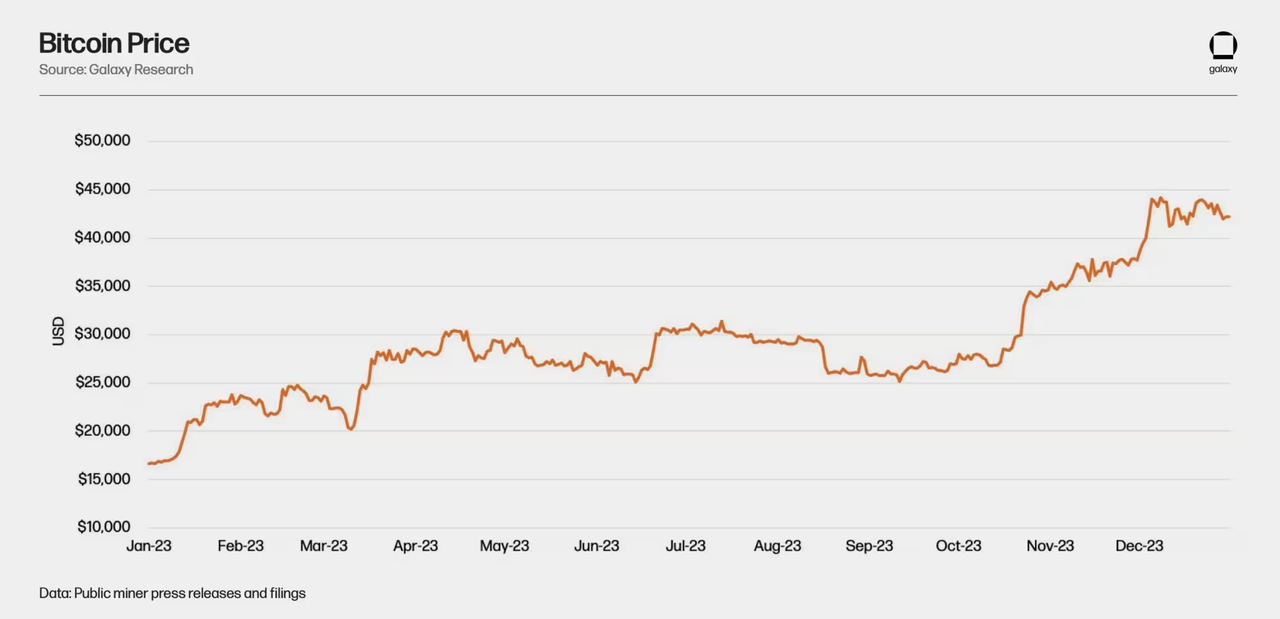
Transaction Fees
The total transaction fees in 2023 amounted to 23,445 BTC, over four times the 5,375 BTC paid by users in 2022. The surge in smart contracts in 2023, especially around the minting and trading activities of BRC-20, led to continuous fee pressure in May, November, and December. In 2023, the fees generated by Ordinals transactions exceeded 5,000 BTC.
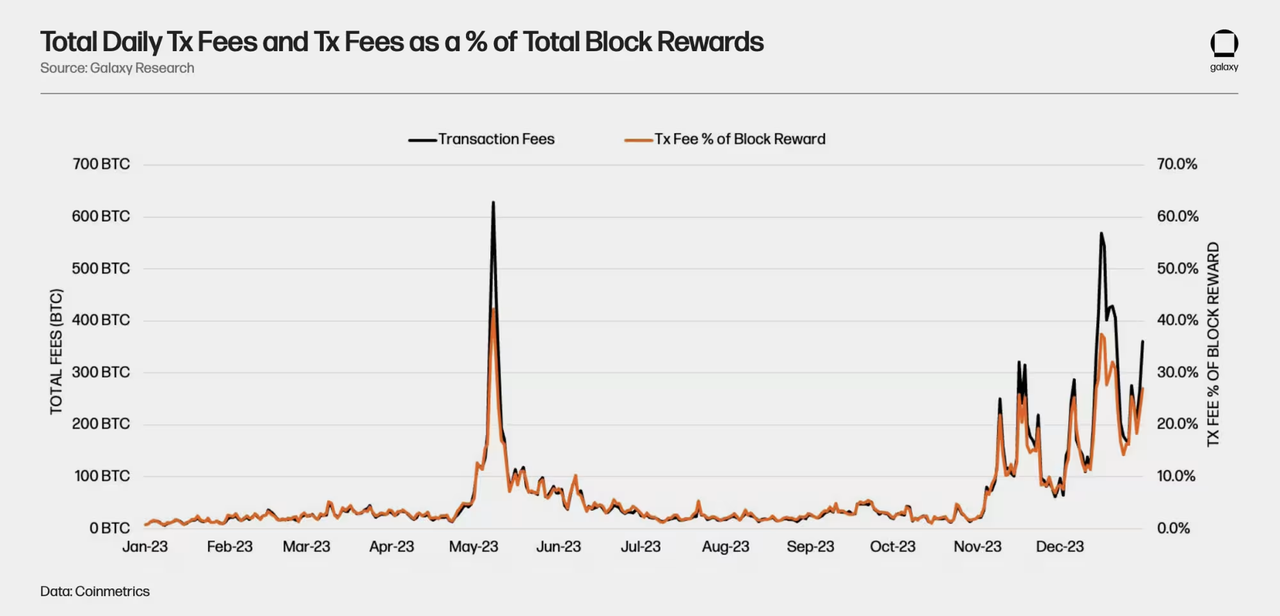
Network Difficulty and Computing Power
In 2023, network difficulty increased from 35.3 T (implied computing power of 253 EH) to 72.0 T (implied computing power of 515 EH), a 104% increase for the year. The increase in computing power in 2023 far exceeded the increases in previous years. Computing power increased by 45.7%, 30.5%, and 34.8% in 2022, 2021, and 2020, respectively. Several favorable factors drove the increase in computing power this year, some of which were outlined in our mid-year report in 2023, including:
- One of the biggest drivers of computing power growth was the delivery and launch of new ASICs in the last bull market cycle that began in 2022;
- Bitmain, MicroBT's new generation of relatively inexpensive mining machines, such as the M50 series, M60 series, S19k Pro, S21, and T21;
- Natural gas prices fell in 2023, reducing miners' energy costs;
- Bitcoin prices continued to rise throughout the year;
- Periodic spikes in transaction fees provided miners with additional income;
- International computing power came online;
- ASIC manufacturers maintained their production capacity at foundries and released new, more efficient models;
- Miners underclocked mining machines to improve their balance of payments;
- Equity capital markets slowly opened in 2023, allowing miners to raise funds for recent growth opportunities.
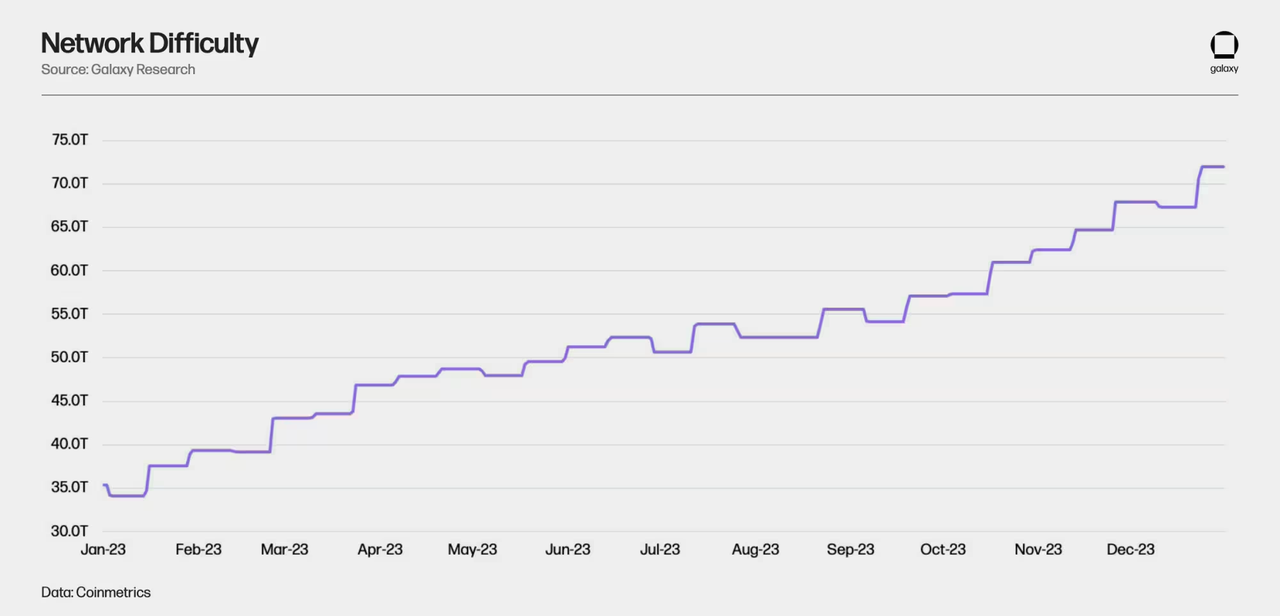
Computing Power Price
The combined changes in Bitcoin price, transaction fees, and network difficulty led to hash price fluctuating between $0.06 and $0.10 for most of 2023. Hash price refers to the expected value of 1 TH/s of computing power per day and is a function of BTCUSD, difficulty, and miner income (block subsidy + fees). The hash price briefly fell below this range at the end of August and exceeded this range during the spikes in transaction fees in May, November, and December.
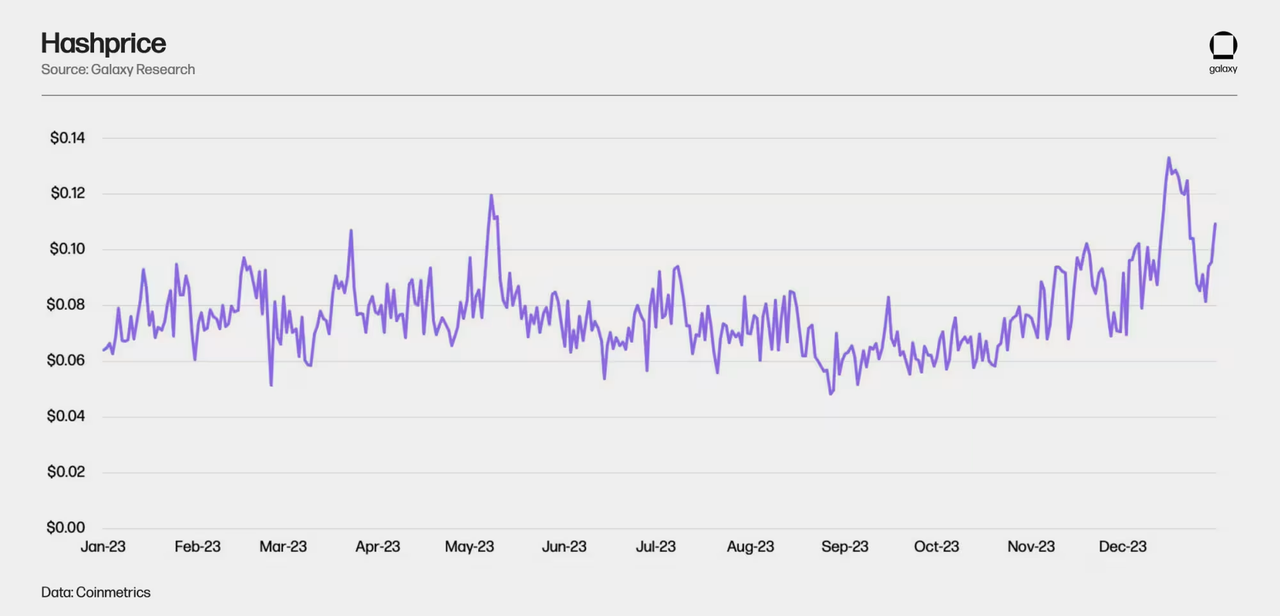
Energy Prices
Natural gas is a key pricing component for the majority of electricity used by global miners, especially in the United States, where it accounts for 30-35% of the global implied computing power. The price of natural gas was extremely stable in 2023. This stability sharply contrasted with the volatility experienced in 2022, when natural gas prices fluctuated significantly, partly due to the turmoil in Eastern Europe, which brought uncertainty to natural gas pipelines and global energy trade. During this period of widespread uncertainty, there was an urgent global need for the production and storage of natural gas. 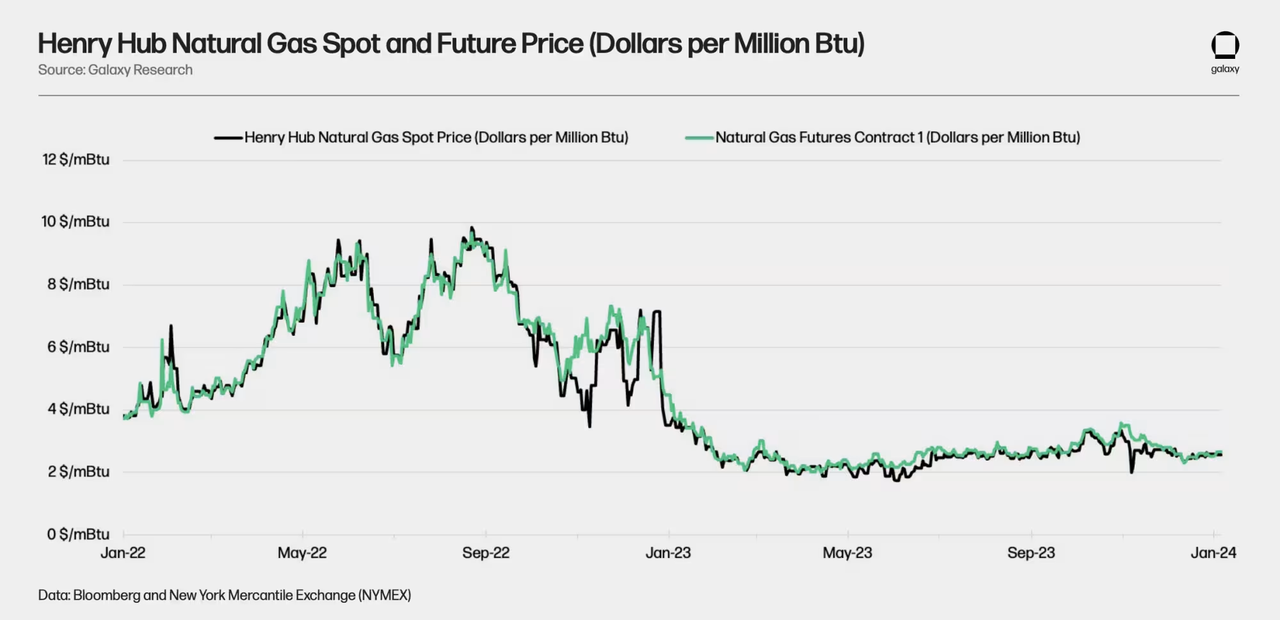
Several factors contributed to the relative stability of natural gas prices in 2023. In the United States, record natural gas production exceeded consumption growth, playing a crucial role in maintaining price stability. Meanwhile, the increase in natural gas inventories further promoted this stability. In the first half of 2023, mild temperatures across the United States led to reduced heating demand, especially in residential and commercial sectors. This consistent and flat pricing trajectory provided miners with a more stable energy cost environment throughout 2023, offering welcome relief in profits and positioning them favorably for the upcoming halving event.
Regulation
Some key legislation in 2023 may affect the operational capabilities of miners, especially in ERCOT:
- Texas House Bill 1929, introduced in the first half of 2023, requires a significant amount of interruptible power for virtual currency mining facilities within the ERCOT power region to be registered, and it took effect on September 1, 2023.
- Texas House Bill 1751 proposed to prohibit miners from participating in ancillary services and grid balancing programs but did not progress further than the congressional level. The bill had a profound impact on industry sentiment as it was the first aggressive legislation targeting the mining industry in the ERCOT region.
- The Digital Asset Mining Energy (DAME) tax, proposed by the Biden administration, would impose a significant new tax on Bitcoin mining operations, although the tax has been removed from the budget, marking a major victory for Bitcoin advocates.
- New FASB rules allow Bitcoin to be measured at fair value on a company's balance sheet. We discussed this rule change in our previous EOY report (2022) and it is expected to benefit miners with significant BTC holdings, as it allows them to calculate their value at current prices, making their net profit figures more attractive. This change is expected to take effect in 2025 but also allows for early adoption.
- Senator Elizabeth Warren proposed extending the Bank Secrecy Act as part of the Anti-Money Laundering Act to extend KYC to miners.
Developments outside the United States indicate that countries are now competing to attract Bitcoin miners and provide clear regulation for the mining industry.
Russia continues to expand its regulatory framework, considering Bitcoin as an exportable commodity. By equating Bitcoin mining to the extraction of natural resources, Russia not only recognizes the importance of Bitcoin but also incorporates it into its economic framework. This is expected to continue to drive the country's recent expansion into the mining industry and provide a "business-friendly" alternative for countries with stricter policies.
Regulatory Trends in 2024
Last year, the debate about the environmental impact of Bitcoin seemed to shift towards cautious optimism, and we expect this dynamic to continue in 2024, especially as the approval of physically-backed Bitcoin ETFs will change the way institutions approach the industry. The mainstream media's almost hostile attitude towards Bitcoin mining has given way to more nuanced discussions about grid balancing, renewable energy incentives, and waste consumption.
However, we believe that the position of U.S. mining pools may be challenged with the emergence of new Miner Extractable Value (MEV) dynamics and the adoption of new pool technologies.
There is more focus on the role of mining pools and miners in the transaction selection process. In the second half of 2023, two new mining pools (OCEAN and DEMAND) were established, focusing on decentralized pooled mining using technologies such as StratumV2. The main benefit of StratumV2 is that it allows miners in the pool to participate in the block template construction process determined solely by the pool operator. Democratizing block template construction is very useful for decentralized mining, but this feature is opt-in for miners, and due to regulatory risks from a KYC/AML perspective, most miners are unlikely to want to create their own block templates.
Insights and Trends of Listed Miners
Capital Management Strategies
Although income increased for listed miners throughout 2023 due to the significant rise in BTC prices and fees, the amount of BTC sold by listed miners was mostly minimal throughout the year. 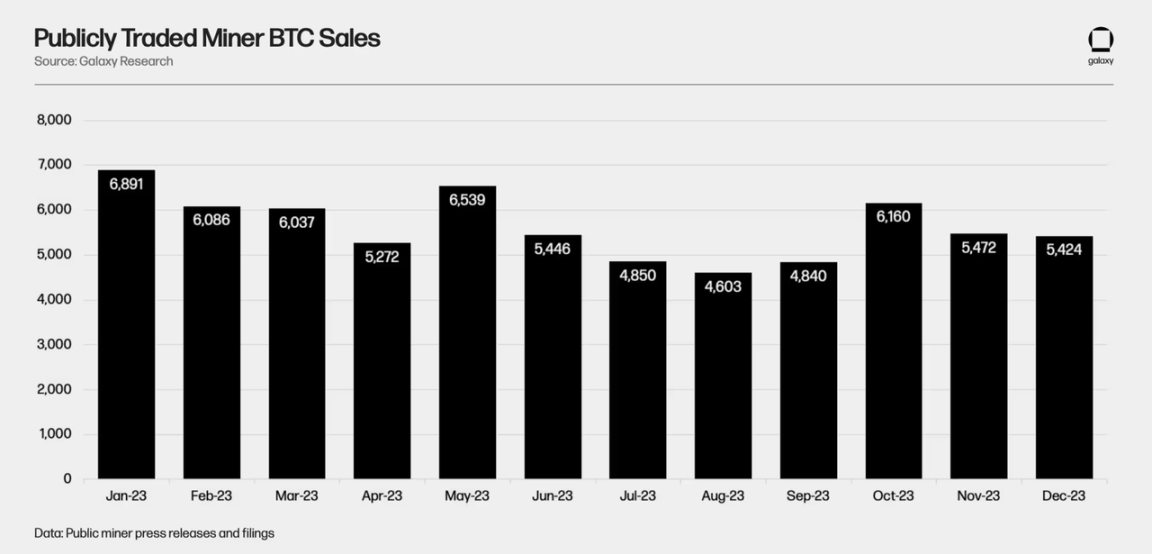
During the bull markets of 2022 and 2021, listed miners essentially adopted a HODL strategy in production. As the market turned and Bitcoin prices fell, many listed miners were forced to sell assets to reduce balance sheet leverage and pay operating costs. Subsequently, the capital management strategies of listed miners have evolved towards a more cautious approach, balancing holding Bitcoin or selling all Bitcoin directly for cash. With the improvement of the mining economy in the second half of 2023, listed miners became more willing to hold more Bitcoin and bear the price risk that may arise from ETF and halving narratives. Now, FASB has updated its guidance to allow listed companies to measure the Bitcoin held on their balance sheets at fair value, which may lead listed miners to accept holding Bitcoin on their balance sheets to a greater extent. 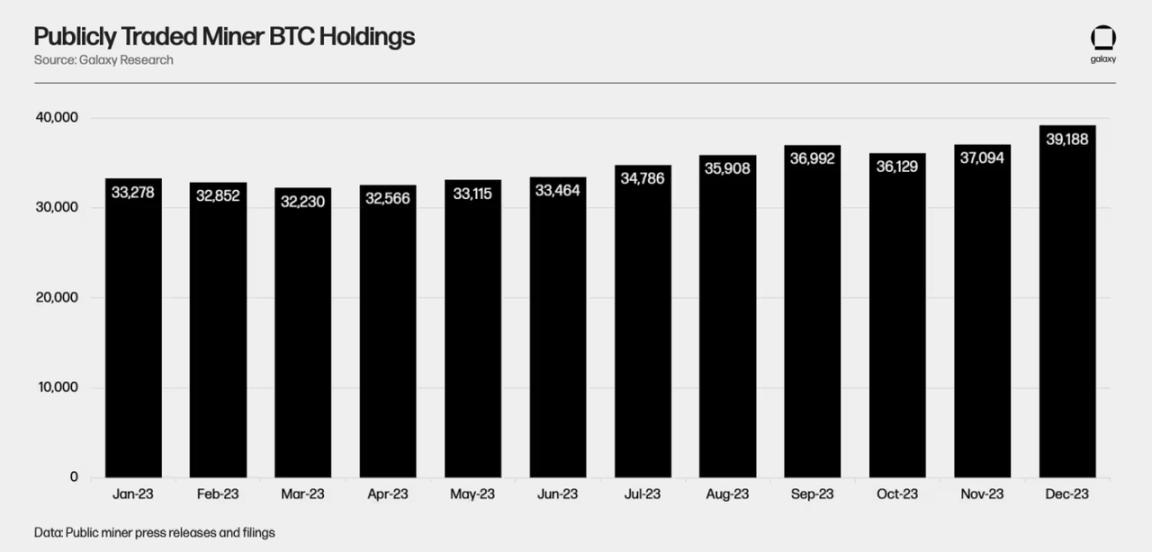
Network Computing Power Share of Listed Miners
The collapse of the crypto market in 2022, coupled with rising interest rates, made it extremely difficult for listed Bitcoin miners to raise new equity or issue debt. As a result, the equity and debt capital markets remained largely closed in the first half of 2023, making it difficult for listed miners to prioritize growth for most of 2023. Miners from other regions also began to reduce the computing power share of North American miners. In the second half of 2023, with the improvement of the mining economy, there was a greater demand for mining exposure in the equity capital markets. North American miners obtained capital through the public markets, giving them a significant advantage over private miners and miners from other regions during the mining growth cycle. 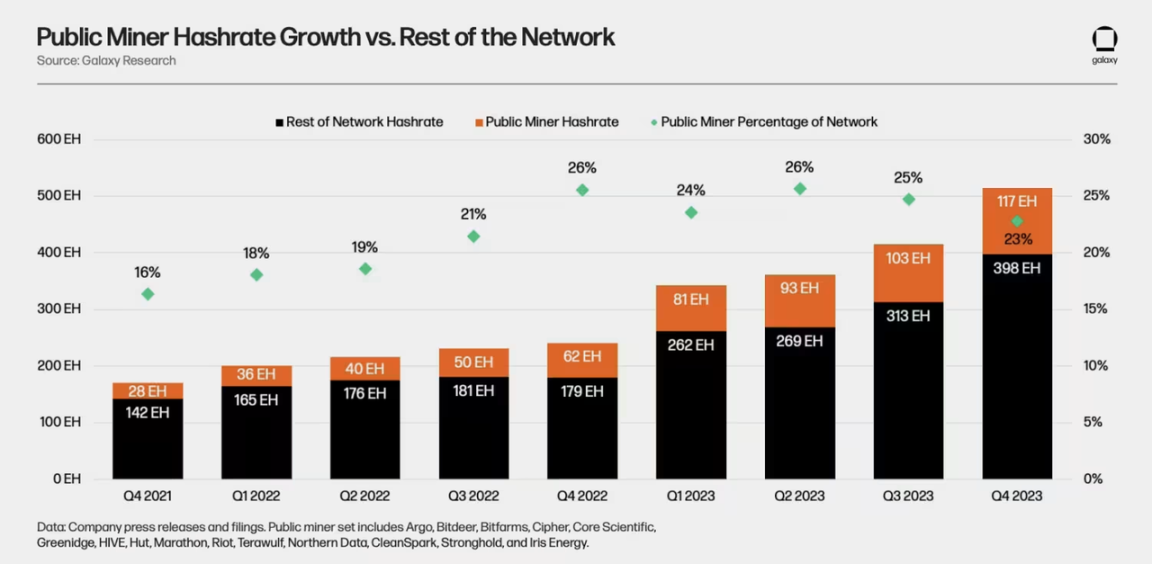
ASIC Mining Machine Investment
In the first half of 2023, most miners were still focused on activating ASIC purchase orders from before 2022, while a few miners made large purchases of ASICs. With the improvement of the equity capital markets in the second half of 2023, especially in the fourth quarter, several miners announced large ASIC purchase orders. It is worth noting that listed miners raised a total of $1.1 billion in equity in the first three quarters of 2023. This situation may further accelerate in the fourth quarter with the improvement of Bitcoin prices and sentiment (financial data of listed miners at the time of writing this article has not been released). Physically-backed Bitcoin ETFs were approved. Compared to equity capital, only $44 million in debt capital was raised, highlighting the extreme challenges faced by miners in relying on debt as a means of growth financing. 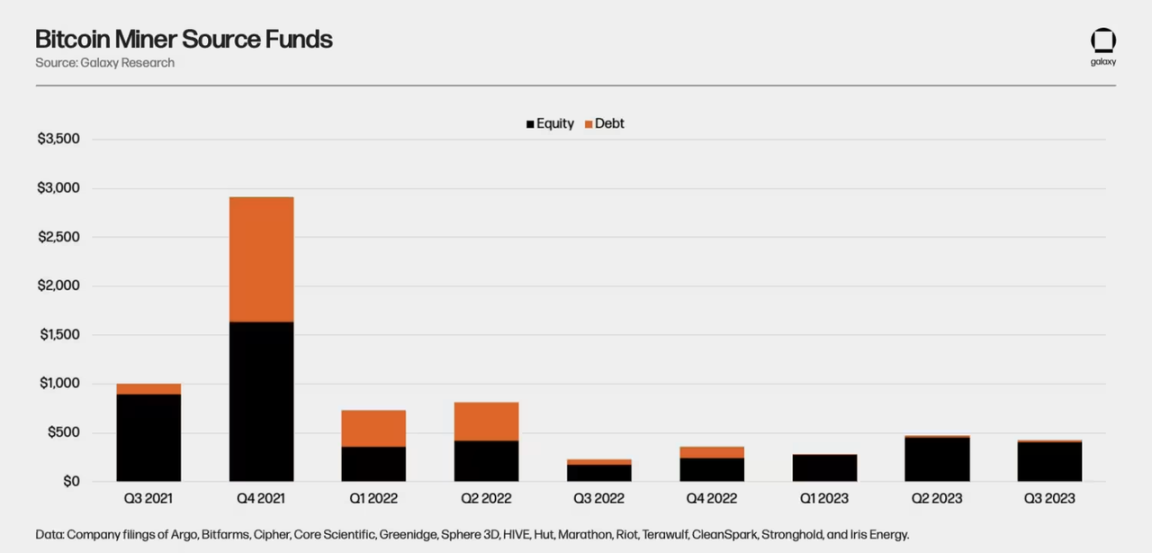
As the rapid approach of the halving in the early second quarter of 2024, the primary focus for miners is to improve fleet efficiency (reduce J/TH), while infrastructure and capacity expansion become secondary objectives. 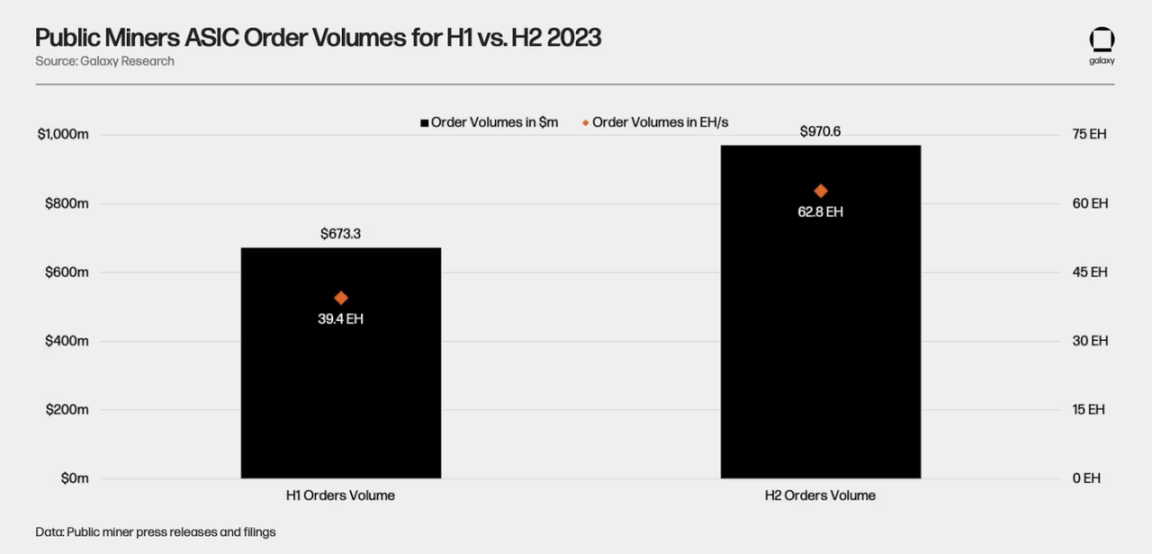
During this year, miners purchased over 94 EH of mining machines, worth over $15.3 billion.
In the second half of 2023, mining machine purchase orders increased by 59.3%, from 39.4 EH to 62.8 EH. Miners were particularly focused on purchasing the next-generation mining machines with efficiency below 20 J/TH, such as the S21/T21 and M66/M56 from Bitmain and MicroBT, respectively.
So far in 2024, miners have purchased over $393 million worth of mining machines, with CleanSpark and Pheonix leading the way. 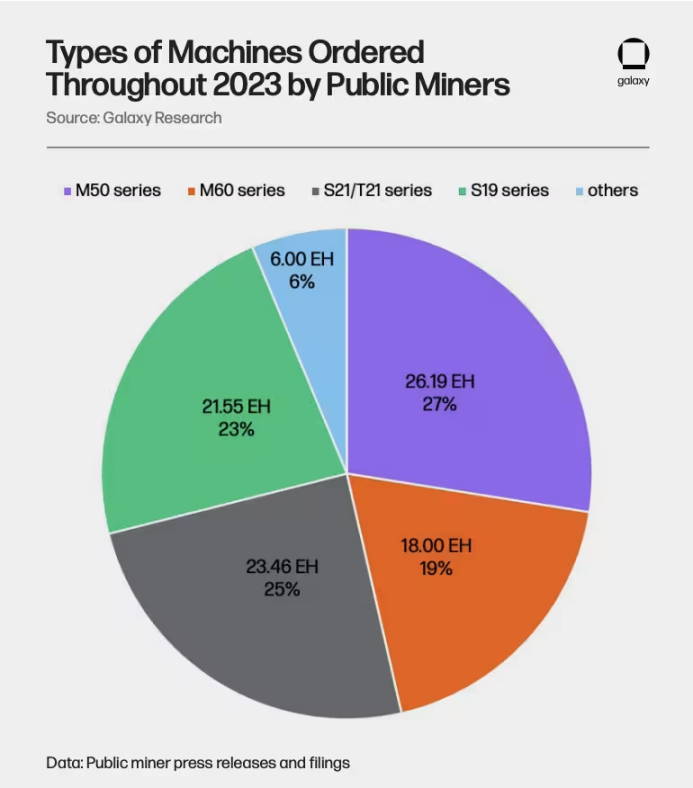
Predictions for 2024
Post-Halving Transaction Fees and Block Space Dynamics
Increased Volatility in Transaction Fees
The block space market underwent fundamental changes in 2023 due to Script and other emerging token standards. As detailed in our reports on Script (Bitcoin Script and Ordinals: A $5 Billion Market) and (Bitcoin Script and Ordinals: A Mature Ecosystem), this year brought incredible new developments for Bitcoin, creating new demand for Bitcoin block space that has not been fully understood or exacerbated by market participants. The direct consequence of this new activity is increased volatility in transaction fees and periods of mempool congestion, indicating that very little activity on the blockchain can push Bitcoin miner fees to sustainable levels (enough to cover the continuously decreasing Bitcoin issuance). The percentage of transaction fees as part of the overall block reward is a common metric used to compare fee levels at different times. In 2023, the network experienced absolute growth in transaction fees, with rewards often soaring to over 25%, equivalent to about half of miner income post-halving. 
In particular, transaction fees generated by Script and similar tokens may become the biggest "wildcard" for Bitcoin miner income in 2024, but this usage is often unstable. Currently, the income of most miners (and mining pools) does not rely heavily on unstable transaction fees. For example, while we might expect hash rate to decrease post-halving, the significant increase in fees during the same period could raise income to a sufficiently high level, allowing less efficient miners to continue mining at a profit, otherwise unprofitable. Additionally, while most industry participants are focused on the impact of the halving on miner profitability, significant changes in transaction fees for specific years could lead to significant fluctuations in hash rate prices, making it more difficult for miners to predict their income.
To mitigate this issue, we suspect further financialization of the mining industry will lead to the emergence of block space and transaction fee futures, allowing miners to hedge against transaction fee volatility. We may even see a new class of opportunistic miners who come online only when fees spike, similar to how Texas miners exploit arbitrage opportunities in the ERCOT electricity market.
The emergence of Bitcoin as a settlement chain for new economic activities (NFTs, DeFi, stablecoins) will solidify demand for Bitcoin block space and bring new mempool dynamics. If 2024 is similar to 2023, we are likely to witness some innovative narrative changes for Bitcoin, bringing new utility to BTC and adding more value to it.
Another consideration for 2024 is the possibility of more complex forms of MEV appearing on the Bitcoin blockchain. In 2023, we experienced two types of "MEV-like" events, both of which had a significant impact on market participants. New "MEV-like" events may also emerge in 2024.
The use of RBF in high fee environments will impact mempool activity
The use of fee bumping has become increasingly common and useful for regular users as fees increase. RBF, or "Replace-By-Fee," is one solution for Bitcoin users to increase the fee of a transaction stuck in the mempool due to fee increases. RBF allows users to increase the fee of a previously broadcast transaction, providing more incentive for miners to include it in a block. Along with other solutions such as Child Pays for Parent (CPFP), RBF is particularly useful during fee peak periods as it allows users to get their transactions confirmed faster when needed. As explained earlier, 2023 was a year of fluctuating transaction fees, making it more difficult for users to set the "correct" fee for their transactions, leading to a significant increase in RBF usage.
In turn, the increased usage of RBF leads to higher fee rates in the mempool and higher miner income. Typical replacement fee rates are 20% to 50% higher than the original transaction fee, providing more incentive for miners to include these transactions in blocks. 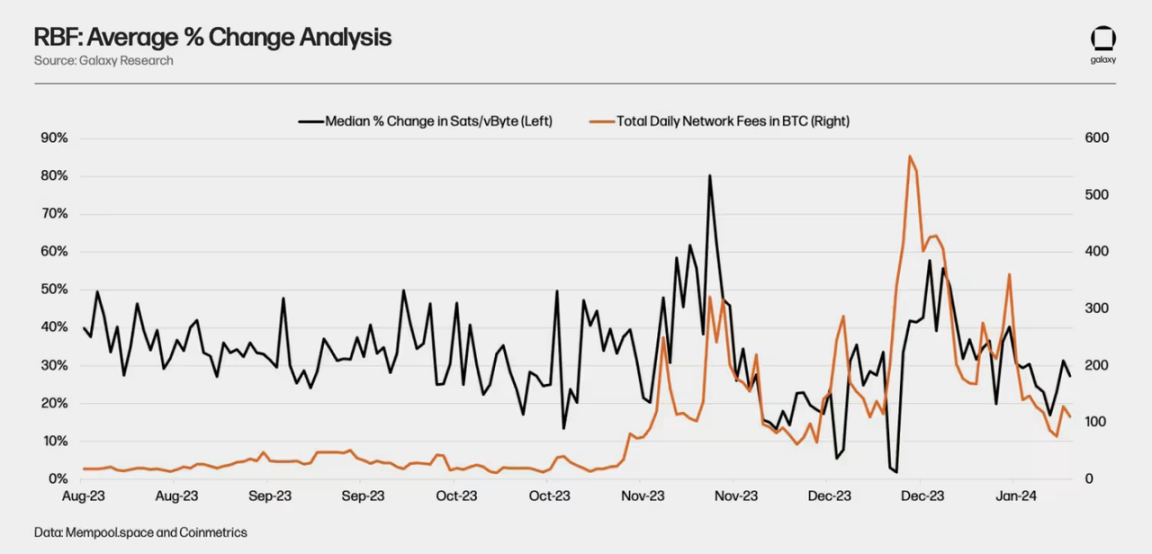
While technically savvy users typically use RBF to increase fees, other solutions have emerged to help regular users. These services, known as "transaction accelerators," are promoted by mining pools such as Binance and data aggregators like Mempool.Space. Accelerators allow users to pay the mining pool directly (using fiat currency or Bitcoin off-chain) to have their transactions included in the next block. These off-chain (OOB) transactions do not reflect in the total reward of a block but can significantly increase miner income.
As competition for block space intensifies, the optimal fee rate for transactions becomes increasingly unpredictable, so with the continued financialization of block space, we can expect OOB transactions to occupy a larger proportion of pool/miner income.
With the ongoing rise in transaction fees, the fee share of RBF transactions will increase in 2024. An unexpected finding from the analysis of RBF replacements is the amount of fees generated by such transactions:
Under normal mempool conditions, the fee share generated by RBF replacements hovers between 10% and 20%, soaring during low fee periods, reaching a peak of 50% in September 2023.
With the halving approaching and the proportion of transaction fees in block rewards doubling, RBF transactions will become more closely related to miners, providing greater incentive for miners to run full RBF nodes to view these transactions in the mempool and include them in their block templates. According to Bitcoin developer Peter Todd's research, as of August 2023, at least 31% of hash power in 4 different mining pools was mining full RBF (potentially up to 70% by January 2024).
Peter Todd's proposal for "One-Time Fee Replacement" will also be a major factor in providing additional incentives for miners to run full RBF nodes. In fact, this new RBF policy will act through "only allowing replacements to occur when [fees] immediately make a transaction close enough to the top of the mempool to be mined in the next block or so," increasing competition among high time preference users on the blockchain. In a sense, this new form of RBF can provide a constant level of demand for the next block, determining the overall transaction fees for miners. 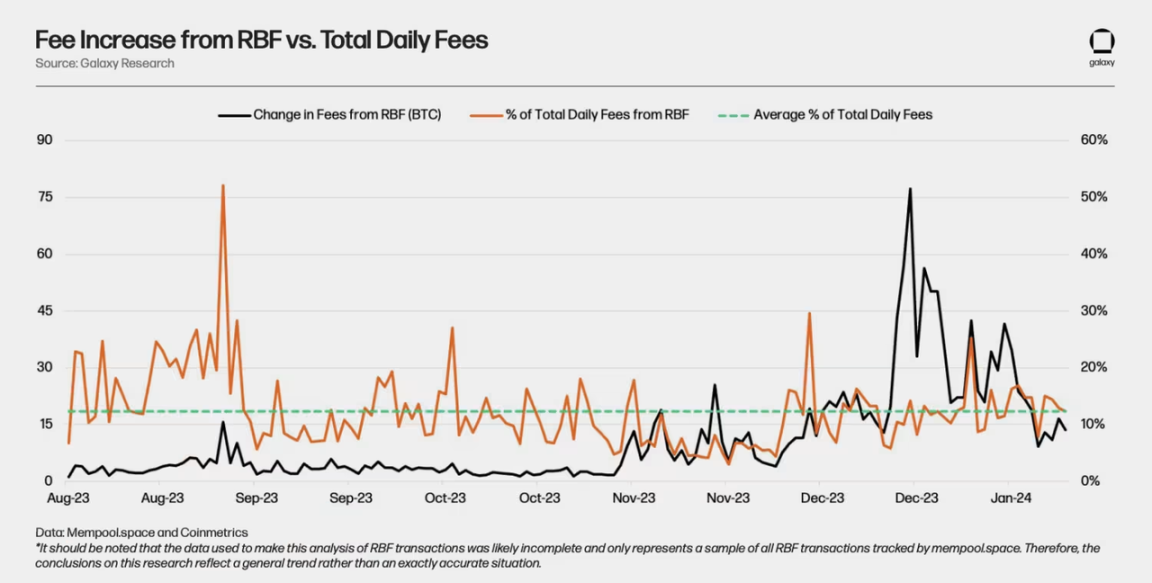
Looking ahead, we expect mempool-centric proposals such as Cluster Mempools, Package Relay, V3 Transaction Relay, and Ephemeral Anchors to provide users with more tools and policies to determine the optimal fee based on their needs, avoiding overpaying for transactions while also benefiting miners by allowing them to build more efficient block templates.
Exploring the Relationship Between Block Time and Fees
Historical data shows a close relationship between block time and fees. Considering that unprofitable miners may go offline during the halving and increased block time periods, in the analysis below, we quantify the impact of increased block time on exacerbating fee pressure.
Except for 2009 and 2021, the average block time has been faster than the 10-minute block interval set by the Bitcoin network. In the past 3 years (since January 1, 2021), the average block time has been 9 minutes and 51 seconds, corresponding to a sharp 262% increase in mining difficulty during the same period, leading us to believe that this phenomenon will affect miner income by naturally reducing fee levels in the mempool. While this concept is easy to understand and logically consistent (more frequent blocks = shorter periods of fee pressure), we find that its consequences are often overlooked.
First, we conducted a correlation analysis of the block time and the median transaction Sats/vByte in each block from block 390,000 (mined in December 2015) to block 825,460 (mined in January 2024) to confirm this relationship with on-chain data. In general, the median Sats/vByte (fees) steadily increases with increasing block time, becoming less apparent as block time deviates from 10 minutes. The graph below shows the total number of blocks mined at different one-minute intervals from 0 to 100 minutes and the median transaction Sats/vByte per block. 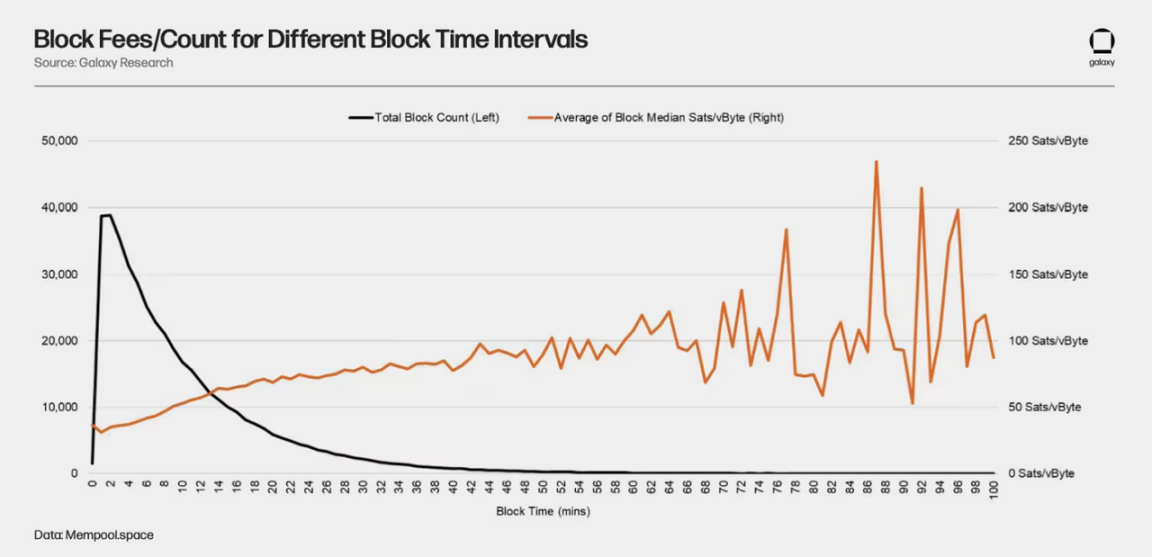
Furthermore, through regression analysis of block time and the median transaction Sats/vByte per block, we can quantify the relationship between these two variables. The analysis below indicates that on average, for every minute that blocks are mined faster than 15 minutes, fees decrease by approximately 2.2 Sat/vByte per minute (or about 4% of the median block fee of 54 Sats/vByte for blocks mined in about 10 minutes). However, for every minute beyond 15 minutes, fees increase by 0.71 Sat/vByte per minute (or about 1% of the median block fee of 54 Sats/vByte for blocks mined in about 10 minutes). We distinguish the trend lines for block times below and above 15 minutes, as there is a noticeable change in slope around that block time. After 15 minutes, the impact of increased block time on fees gradually diminishes. A reasonable explanation for this phenomenon is that after 15 minutes, the block template may be close to its final form, and unless there are any significant changes in the mempool (i.e., from the ordinal set being written to), it becomes increasingly unlikely for other transactions to replace the expected transactions in the block. 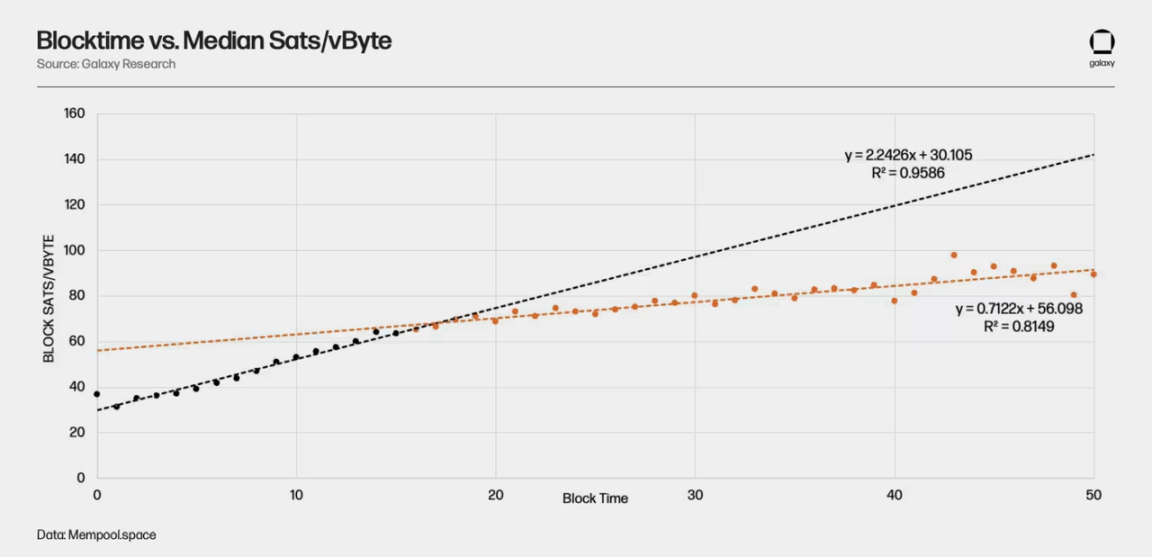
The implications of these findings are that in recent years, with the expansion of network hash power, fees naturally decrease, and this is expected to continue into 2024, but there may be exceptions after the halving, when a decrease in hash power may increase fee pressure.
While hash power itself may not be the primary catalyst for overall fee rates, it undoubtedly has the potential to amplify existing fee rate dynamics. For example, the recent surge in fees has been primarily driven by a surge in block space demand, rather than a corresponding change in hash power. However, if block times slow down in 2023, it could exacerbate these peaks, leading to longer intervals between blocks and a more pronounced accumulation of fees.
Next, we use the above content to understand the impact of the relationship between block time and transaction fees on miner income, as transaction fees become more important post-halving. By extending these analysis results to overall mining income, we can begin to explore how the halving and continued competition among miners to increase mining capacity will affect fees. An example of how miner activity affects block time and fees is when most miners in ERCOT simultaneously reduce their operations due to high electricity prices, causing network fees to suddenly rise.
To illustrate this point, if we expect approximately 20% of network hash power to go offline during the halving, then on average, block time will increase by 20% before adjustment. This is because of a mechanism called "difficulty adjustment," where mining difficulty (the average expected time to find a block) is adjusted every two weeks (2016 blocks) to keep block time at around 10 minutes.
Using the relationship we derived for block times less than 15 minutes, this would lead to an average fee rate increase of approximately 8% (12 minutes of block time, meaning 2 minutes higher than the 10-minute target, multiplied by a 4% increase per minute - all else being equal). To put this into perspective, if we apply this to a fluctuating fee period, such as epoch 407 (an upward adjustment of +6.98% between blocks 820,512 and 822,528), an 8% increase in fees during this difficulty period would mean an additional 355.7 bitcoins (calculated at a bitcoin price of $42,000, totaling $15 million) in miner fee income.
On the other hand, if the average block time in 2024 is approximately 9.5 minutes (the average block time in 2023 was 9.74 minutes), we can expect a theoretical negative impact on miner income of about 2% of transaction fees. (This analysis focuses solely on the impact of hash power on fees, not the income increase associated with the post-halving difficulty reduction).
* However, some may argue that the additional income from receiving more block subsidies in a given year, as miners mine more blocks than the network expects, will largely offset the income loss from suppressed fees. In fact, both perspectives are valid and depend on your time preference (i.e., miners generating more income in a given year, but accelerating another halving by mining blocks faster).
In conclusion, the increase in Script activity, the increased use of fee replacement (RBF), and the slowing of block times may collectively coordinate to cause an unprecedented surge in fee pressure and volatility coinciding with the occurrence of the halving in April.
Risk Management Strategies
Electricity Hedging
The expected volatility in hash prices during the upcoming halving in April 2024 adds an additional layer of complexity to miners' energy strategies. Miners distributed across different geographical regions operate their electricity in various ways, including standard grid connections, hosting renewable energy, and waste gas generation, among others. Miners facing variable grid pricing worldwide need to take a cautious approach to their energy management strategies.
The table below shows the breakeven income per megawatt-hour (in USD) generated under different combinations of queue efficiency and hash prices. Electricity costs higher than this breakeven threshold will result in ASICs being unprofitable. At the time of writing, the hash price is $0.082 (BTC price is $43,000, 10% fee, 520 EH), and under the same conditions, the hash price is expected to decrease to $0.045 after the halving. At this hash price level, miners with a fleet efficiency of 30 J/TH would need an energy price below $63/MWh to achieve positive gross profit. 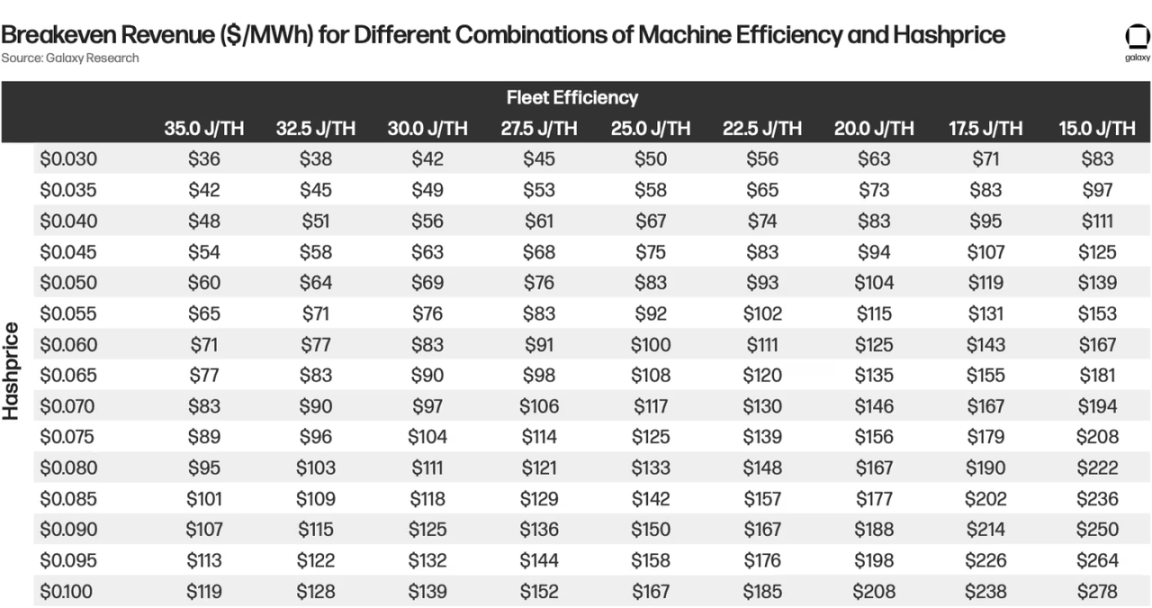
Some miners with grid interconnection face the task of determining the total capacity ratio they want to hedge. Miners opting for more indexed exposure face the risk of long-term energy prices exceeding their fleet's breakeven point, leading to increased downtime and reduced Bitcoin mining. Miners hedging energy prices can withstand energy price fluctuations and gain upside risk, but there is also the risk of locking in a fixed hedging price that exceeds their breakeven point and spot electricity settlement price.
The analysis also indicates the need to prioritize machine efficiency. In the above scenario, if the hash price is below $0.07, older generation machines with an efficiency of 35 J/TH would be unprofitable, while machines composed of S21 would need a hash price below $0.04 to be profitable, hedging electricity costs at $80/MWh. In a hosting environment, miners with new generation machines can still withstand higher fixed cost contracts after the halving.
We can also observe the impact of efficiency improvement on gross margins. In the table below, we adjust the previous table, assuming a fixed energy price of $80/MWh, and calculate the gross margins of different efficiency machine clusters at different hash price levels. 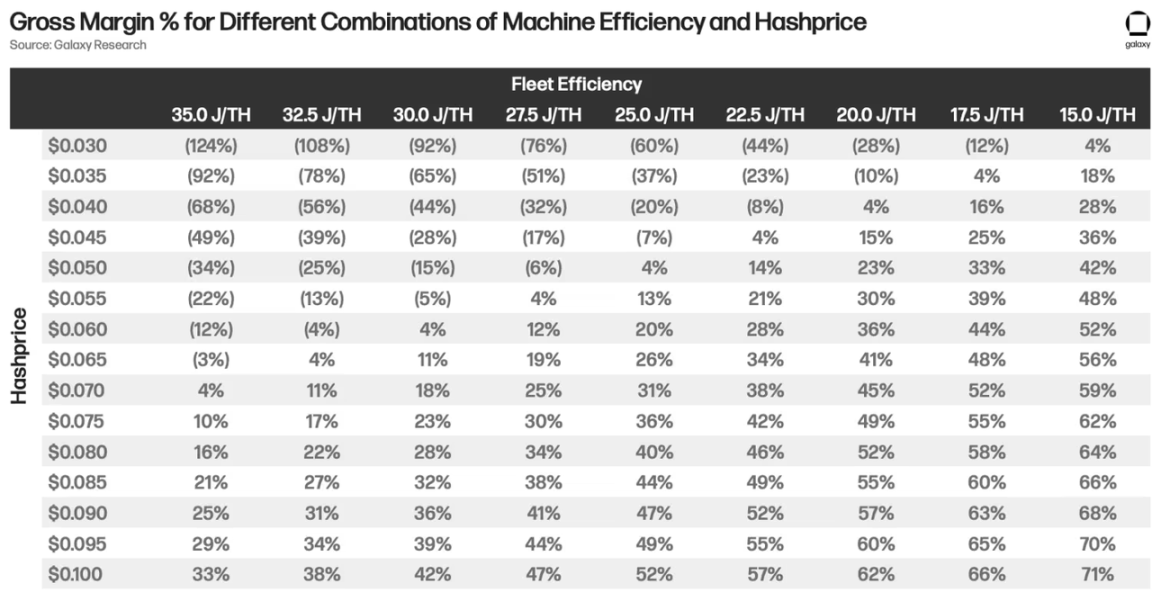
The table shows that at a hash price of $0.07, the cluster with an efficiency of 35 J/TH generates a gross margin of only 4%, while the cluster with an efficiency of 17.5 J/TH still maintains a strong 52%.
In conclusion, the decision for miners to enter into different forward hedges becomes complex post-halving and largely depends on fleet efficiency. Miners face the risk of entering into hedges where the fixed price they take exceeds the machine's breakeven point and spot electricity price, resulting in either unprofitable mining or hedging at currency prices.
Production Hedging
Bitcoin mining has interesting similarities with traditional commodity production businesses, such as practices in the oil and gas industry. In some cases, the similarities are striking. However, there are significant differences in the field of risk management, which may receive more attention from listed miners and may lead to more disclosure.
2023 is a turbulent period for miners, especially against the backdrop of block rewards. As we mentioned earlier, this volatility can be attributed to innovative bidding strategies and the surge in transaction fees due to block space utilization. With the anticipated halving event approaching, miners find themselves increasingly reliant on transaction fees to sustain income and offset the impending reduction in collective subsidies. This high dependence and the accompanying uncertainty are driving miners to explore hedging strategies, becoming a key element in more robust risk management practices. This move aims not only to reassure investors but also signals a strategic shift towards utilizing a variety of derivatives that suit their risk profile and speculative tendencies.
While there are several positive aspects to using such derivative products, they also bring many challenging issues that may lead to a scarcity of seller products and a lack of buyer activity. The complexity of these contracts, particularly the differences between cash settlement and physical settlement variants, presents significant challenges. In particular, contracts with physical settlement bring significant counterparty risk, involving not only the hash power operator (miner) but also the mining pool they choose and other factors that affect normal operating time.
The market reflects these complexities, with the lack of liquidity in these structured products being evident, highlighting their inefficient pricing. As we enter 2024, a new year brings a new perspective on the fluctuation of miner income, caused by the halving and the rise in ordinal and startup activities. The evolving landscape prompts a reassessment of the complex dynamics surrounding these derivative contracts.
In addition to hash power derivatives, miners have a wide range of choices to hedge and integrate various risk management products into their strategies. This includes options, costless collars, and forwards. These simple structures have high liquidity and short execution times.
Bitcoin Miner Strategy Divergence
In 2023, due to the lower hash price in 2022 and the uncertainty of the upcoming 2024 halving event, there has been significant divergence in the business models of Bitcoin miners. Subsequently, the entire industry has reflected on its cost structure, prompting miners to seek ways to improve profit margins. As electricity costs account for a significant portion of total cash outlays, miners have refined their energy strategies and moved closer to the source through vertical integration to avoid additional hosting costs. In this paradigm shift, miners with hosting business lines find themselves forced to readjust contract economics to better align with mining cash flow. Finally, with a decrease in mining industry capital, some miners have ventured into high-performance computing (HPC), attempting to leverage other sources of capital, particularly in the case of soaring valuations in the artificial intelligence industry. Below, as the halving approaches and the approval of spot Bitcoin ETFs, we will delve into the feasibility and impact of these different business models in 2024.
Vertical Integration
By 2024, we expect increased volatility in hash prices, driven by fee/mempool dynamics, the approval of spot Bitcoin ETFs and their impact on prices, and potential significant difficulty fluctuations post-halving. To better protect themselves from the impact of hash price volatility, we anticipate miners will push for further vertical integration, positioning themselves lower on the cost curve by eliminating additional costs from hosting intermediaries. For those lacking infrastructure, proprietary mining businesses can certainly help miners generate cash flow on machines, and miners opting for this route will have to focus on inserting new generation machines and finding hosting partners with favorable conditions.
Hosting Business
The hosting landscape will undergo changes in 2024. Hosting providers may prioritize working with clients who can insert new generation machines with a higher breakeven USD threshold to ensure clients can stay online as much as possible.
Contracts signed, especially with miners owning older machines, must also be constructed in a manner consistent with the miner's cash flow generation. This means that hosting contracts will shift from fixed price contracts to cash flow splits, especially for clients seeking to insert older generation machines. Cash flow splits enable hosting providers to benefit from an increase in hash prices, while miners can remain profitable in the event of a decrease in hash prices. Energy reduction splits may also become common, providing energy price upside risk for both miners and hosting providers and reducing the overall cost of mining Bitcoin.
Hosting still provides a capital-efficient way for miners to grow, monetizing as much available power as possible by filling temporary capacity available for third-party machines. Enterprises that can effectively manage energy prices can generate relatively stable cash flow, contributing to infrastructure underwriting.
High-Performance Computing (HPC)
Due to the low hash price, lack of funds available to support mining growth, and the booming development of artificial intelligence, some miners announced expansion plans into the HPC data center field in 2023. The goal of these companies is to diversify income sources before the halving and gain different sources of capital. The scarcity of large-scale power in the US primary and secondary markets further drives miners to transition into HPC.
The transition from Bitcoin mining to high-performance computing is a complex task, and the business models are fundamentally different. From a construction and design perspective, HPC data centers have a more complex parallel network structure, fine-tuned to optimize data throughput for faster processing times. They also adhere to stricter redundancy and cooling requirements to minimize downtime. While uptime requirements depend on the client and can be relaxed in some cases, HPC data centers must also have appropriate caching mechanisms to seamlessly resume operations from interruption points when the system comes back online, which is not the case for Bitcoin mining data centers. As a byproduct of these more intricate construction specifications, the capital requirements for building high-performance computing data centers are several orders of magnitude larger than Bitcoin mining data centers.
From an operational and financial perspective, these businesses also have differences. HPC enterprises can coexist with other cloud service providers (CSP) or create their own cloud platforms. The former is much simpler, with data center operators entering into lease-type agreements with CSPs and focusing primarily on site management with minimal interaction with end-users. Cash flow in this leasing structure is typically stable and recurring, with profit margins higher than mining hosting businesses. In the latter, the company must establish a broader software, sales, and billing team to expand its customer base and enhance user experience. Unlike the leasing scenario, providing cloud services may also mean that data center operators invest in GPUs for interaction with the cloud platform. This adds a significant amount of additional capital required. However, as CSPs, these companies may be able to charge higher fees to end-users, bypassing the intermediate CSP that interacts with the end-user.
There are also external variables that companies cannot control, bringing risk to operational vitality. Soaring demand for new generation GPUs and related infrastructure has led to mid-term supply shortages, making it difficult for businesses to receive equipment on a predictable schedule.
While cash flow generated from high-performance computing may be higher and less volatile compared to Bitcoin mining, the success of this business sector is most dependent on the ability to execute in construction, design, operations, and finance, while also mitigating the external risks mentioned earlier. Companies entering this field in 2023 are still in the early stages of growth, and 2024 will be a true test of their survival.
Entering HPC during the bear market helped miners find new sources of funding in 2023. However, there are inherent opportunity costs in allocating power to Bitcoin mining compared to HPC workloads. With the approval of spot Bitcoin ETFs and capital expected to flow back into the industry, companies may reconsider focusing on the continuously growing mining business. In the long run, companies expanding too quickly in high-performance computing may find reduced correlation with Bitcoin prices and limited upside, as investors value the business more as a traditional data center rather than a Bitcoin proxy.
Impact of Bitcoin ETF on Miners
With the approval of Bitcoin ETF products, investors now have direct access to Bitcoin prices. Before the approval of ETFs, publicly listed mining stocks were one of the few traditional tools through which investors could gain exposure to Bitcoin price appreciation. In the short term, the approval of ETFs is likely to be a factor for investors considering investing in public mining stocks. Retail investors may continue to view mining as leveraged long Bitcoin trades and use ETFs as the primary performance benchmark. On the other hand, institutions seem more likely to long Bitcoin ETFs in the short term and short mining stocks, a trend we have seen since early 2024.
In the long run, Bitcoin ETFs are expected to pose competition for listed miners. With more savvy investors entering the market, Bitcoin miners will have to prove why they are a better investment than spot Bitcoin through their earnings. Miners' beta values and trading multiples with Bitcoin should depend on their ability to generate strong free cash flow. This may pose financing challenges for operators with lower profit margins, higher costs, and a poor track record of capital returns. Stock prices of miners should also react more negatively to dilution as a means of growth financing, unless miners can demonstrate a strong prospect of capital returns, as investors can buy ETFs without worrying about dilution. However, Bitcoin miners can benefit from the inclusion in a wider range of ETF and fund products, as well as research and reporting, outweighing some of the drawbacks of increased competition from Bitcoin ETFs.
Mergers and Acquisitions
The fourth halving still brings potential challenges. While upgrades and joint ventures help enhance operational flexibility, miners unprepared for the halving may find themselves at a disadvantage. The increase in M&A activity in 2024 is partly due to the following reasons:
Attractive small caps: Public mining companies with smaller market capitalization may become attractive targets for miners with better capital and stronger liquidity, especially those with lower debt levels.
Targeting vertical areas: Private mining companies, especially those with high levels of vertical integration, may become targets for participants with synergies, who can lower mining costs and better control their destiny through acquisitions or mergers. For example, some miners with lower levels of vertical integration lack the ability to reduce operations when their hash power exceeds breakeven prices.
Value trades: Private mining companies with lower valuations, undergoing restructuring, or seeking a path to survival may be attractive acquisition targets. Acquirers may view these as value trades and expect future gains as market conditions improve.
Physical options: The mining business demonstrates immediate cash flow positivity, assuming low energy costs and minimal operating expenses at current hash price levels, providing an attractive entry point for robust IRR. This claim becomes more attractive when site acquisition costs fall within an acceptable range, especially when managed by operators with experience in operating mining facilities. Additionally, sites located in relaxed regulatory markets may be seen as more valuable by bidders, as these facilities can act as proxies for monetizing power that would otherwise face energy cuts. The strategic positioning of mining businesses in such markets enhances their value proposition, aligning with the broader trend of industry participants seeking to optimize operational efficiency.
Over the past year, miners have faced funding constraints and poor liquidity. The strategy of raising funds through ATM stock issuances, despite significant discounts and shareholder dilution, was primarily aimed at upgrading ASIC fleets, making miners more urgently seek suitable sites to accommodate the influx of hash power.
With existing sites operating at full capacity and limited understanding of additional capacity, there is an opportunity to explore the acquisition of sites or entities that can accommodate incoming orders. Finding such opportunities may be challenging, as many power delivery schedules extend to 2025-2026, and there are long lead times for the delivery of power infrastructure. However, 2024 will be a crucial year, as these networks are ready to fill this new hash power. The current trading conditions for miners are much better than in early 2023, and they are eager to make acquisitions to meet their growing liquidity and capacity needs.
Hash Rate Forecast
Estimating network hash rate during the halving is an extremely difficult task, as the sensitivity of various assumptions has a significant impact on the economic feasibility of mining. Nevertheless, we used a top-down approach, utilizing a range of scenario modeling to attempt to provide a reasonable expected range for year-end network hash rate. We proposed a method for forecasting hash rate. There are other methods that could be adopted, such as a bottom-up approach, which may yield slightly different conclusions. Based on our analysis, we expect the year-end network hash rate in 2024 to be between 675 EH and 725 EH.
Method
In our preliminary analysis, considering different Bitcoin price levels and different implied hash price levels post-halving, we assessed how much hash power the network can withstand, assuming transaction fees are 20% of block rewards. 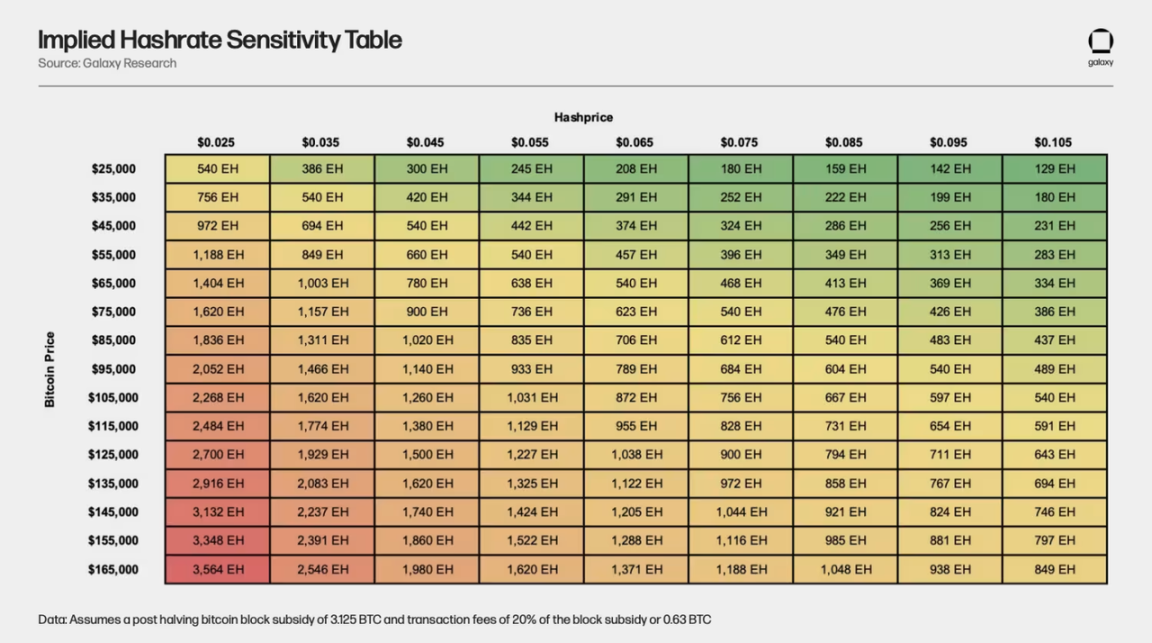
Using the table above, we can see the implied hash rates at different levels of hash prices and BTC prices. We estimate that with the increased vitality of the new generation of mining machines, the new hash price breakeven lower limit for the network after the halving may be $0.035. To arrive at this estimate, we analyzed the breakeven hash prices of various ASIC models at different electricity costs. We use the $0.035 breakeven lower limit as a reasoned guess for the low point of hash prices in the next cycle, representing a 36% decrease from the low point of hash prices in the current cycle. Additionally, $0.035 represents the average breakeven hash price for the new generation of mining machines, with an electricity cost of $75 per megawatt-hour. 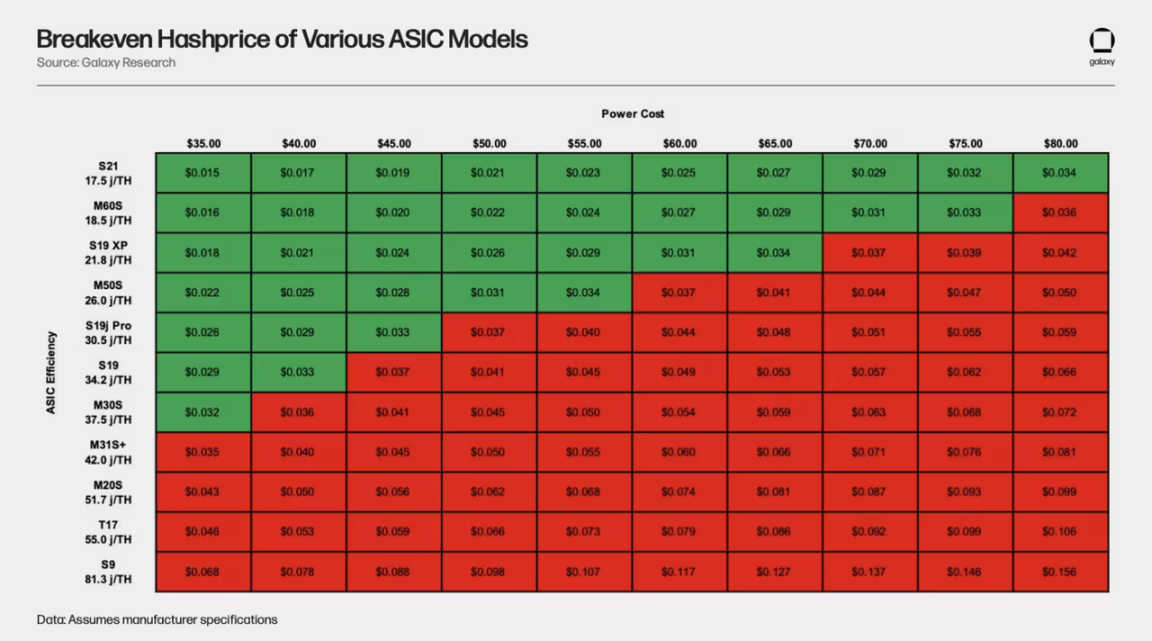
As the analysis shows, even with relatively high electricity costs for miners, the latest generation of mining machines (such as the S21, T21, or M60S series) can still be profitable at very low hash prices. This indicates that there is still significant room for hash rate growth after the halving, even if the Bitcoin price does not substantially improve. Furthermore, if miners can access cheap electricity or underclock their machines, they can still be profitable by operating the S19j Pro. Since the S19j Pro currently accounts for the vast majority of the network, we may not see a significant portion of these machines offline after the halving.
Based on these two studies, if the Bitcoin price in 2024 is between $45,000 and $55,000, assuming a hash price lower limit of $0.035, the network hash rate could reach as high as 694 EH – 849 EH. To be profitable under these conditions, the majority of the ASICs constituting the network would likely be the S21, T21, M60S, S19 XP, and M50 series. However, the main constraint will be the supply chain and production of these new generation machines, as well as the capital to acquire them. Based on the current delivery schedule, we are likely to see the new generation of machines surpass the S19 and M30 series machines by 2025.
Next, we want to understand some limitations to hash rate growth, such as infrastructure availability. To do this, we quantified how much hash rate the network could accommodate if we assume that all existing machines are currently replaced by the new generation of machines. In the left column of the table, we sensitized the current network efficiency to calculate the implied power capacity supporting the network (assuming a network hash rate of 500 EH). 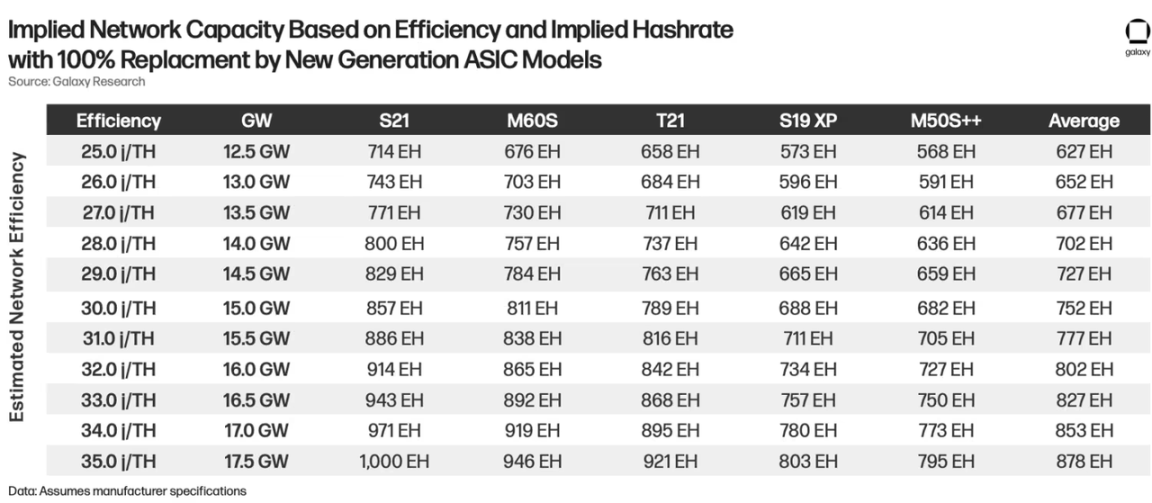
If we assume the average network efficiency of existing machines is 30 J/TH, equivalent to 15 GW of power capacity, and if we assume that each existing ASIC in the network is replaced by the distribution of ASIC models proposed in the analysis. 30 J/TH is a reasonable benchmark assumption, as it is equivalent to the efficiency of the S19j Pro mining machine.
Next, assuming the average efficiency of machines in the network is 30 J/TH, we calculated the net growth in hash rate by replacing existing machines in the network with the new generation of machines. The previous sensitivity table reflects the theoretical upper limit based on the assumption that all machines in the network are replaced by the new generation of machines. However, in reality, we know that this scenario is highly unlikely to occur due to supply chain and capital constraints, as well as miners' ability to profit from operating older generation machines through underclocking or lower electricity costs. 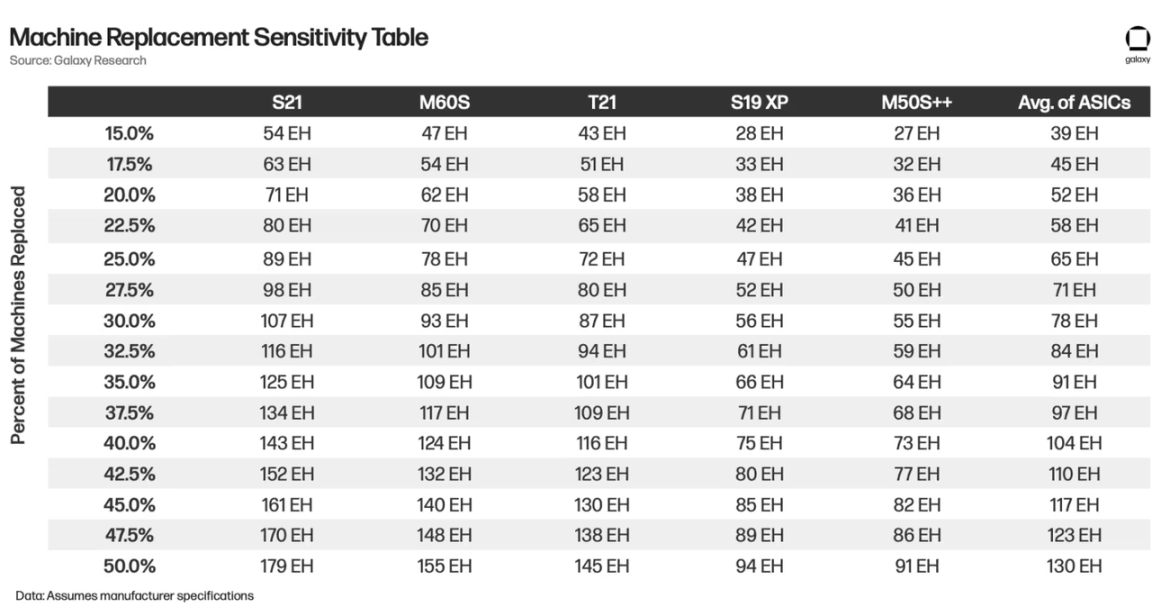
For example, the table indicates that if we assume 25% of machines are replaced by M60S machines, the network hash rate will increase by a net of 78 EH.
Next, we created a sensitivity table for additional infrastructure capacity that may be activated in 2024, assuming this new capacity will be activated through various new generation ASIC models. If we assume the average efficiency of machines deployed in 2023 is 30 J/TH, this implies an additional capacity of 8 GW for that year. However, the growth and expansion capacity delivered in 2023 is largely attributed to the investment cycle in 2021. 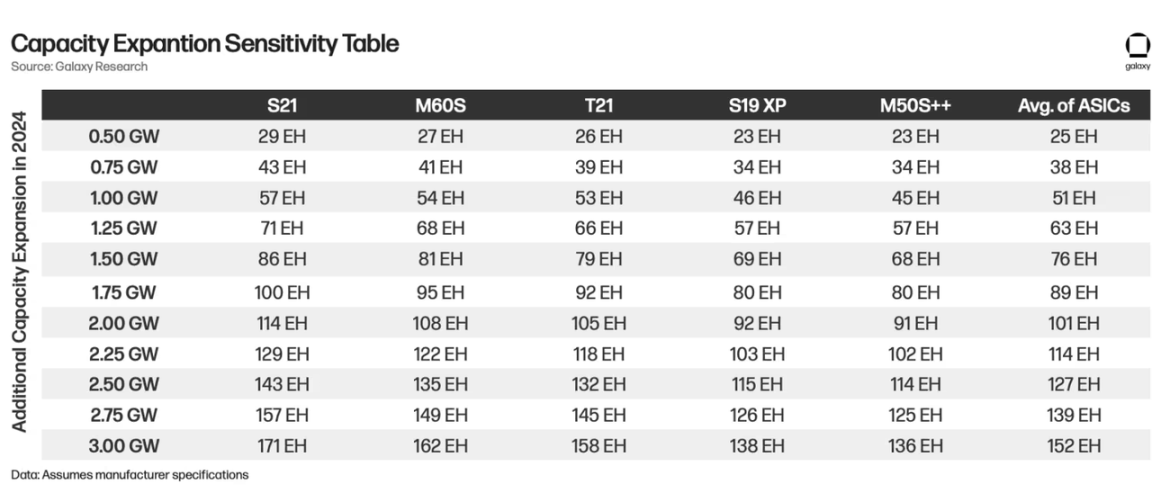
To bring all the analyses together, we combined the results of the machine replacement sensitivity table and the expansion sensitivity table to create the table below, which shows the total potential hash rate range at the end of 2024. The annual network hash rate is 500 EH, and we added the hash rate added to the network due to various capacity expansions, as well as the percentage of existing ASICs in the network being replaced (assuming a uniform distribution of S21, T21, M60S, S19 XP, and M50S++ machines). 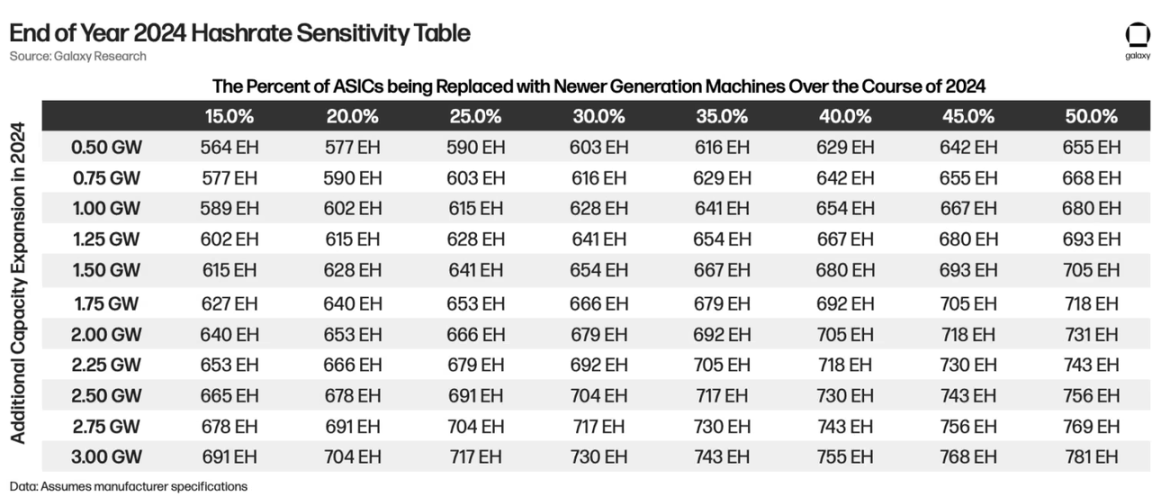
With public miners' announcements about infrastructure expansion and ASIC purchases, we believe that an additional 2 – 3 GW of infrastructure capacity will be added in 2024, and 25 – 35% of existing ASICs will be replaced by new ASICs, which is reasonable. Based on our analysis, the estimated hash rate range at the end of 2024 could be 675 EH to 725 EH, representing a 35 - 45% increase in network hash rate for that year.
Potential Offline Hash Rate at the Halving
According to Coinmetrics data, by the end of 2023, approximately 19.7% of the network hash rate was composed of M20S, M32, S17, A1066, A1246, and S9 machines. The year-end network hash rate was approximately 515 EH, and the implied contribution of this group of machines to the network hash rate was 98 EH. To estimate the percentage of machines that may go offline, we calculated the breakeven USD/MWh for popular ASIC models in the network, including a 3.125 block subsidy and 15% of transaction fees as a percentage of rewards, with a Bitcoin price of $45,000. We then combined prospective electricity prices and implied electricity costs for publicly listed miners to understand the percentage of offline hash rate estimated from the ASIC models described below. 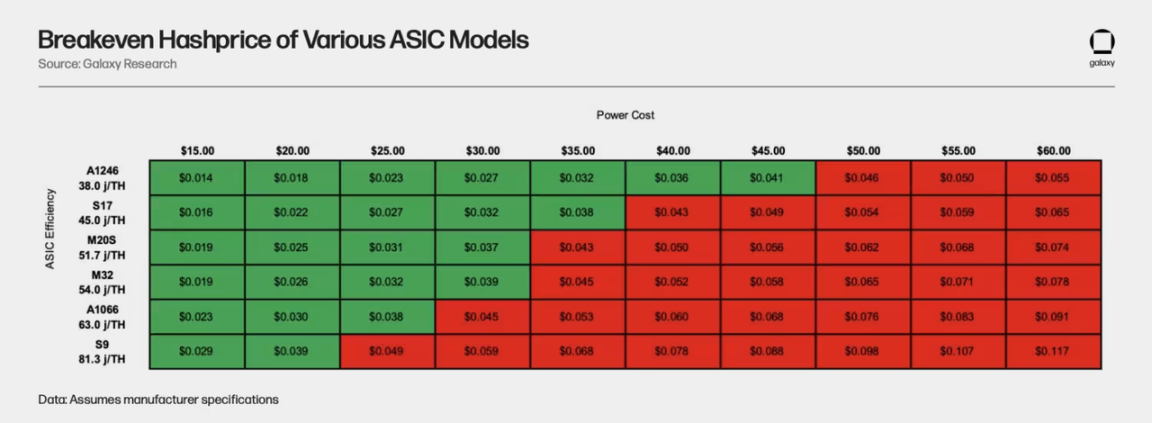
Considering how sensitive the breakeven of various ASIC models is to Bitcoin prices and the percentage of transaction fees as a percentage of rewards, we estimate that 15 - 20% of the network hash rate from the ASIC models described below may go offline, which means between 86 - 115 EH.
Miners of these older and less efficient machines are likely running custom firmware to increase the efficiency of their ASICs, thereby raising their breakeven thresholds. Additionally, certain ASIC models are likely not to completely exit the network but rather be sold to miners with cheaper electricity costs. For miners who can no longer run S19 machines and need to upgrade, those currently running S17 or less efficient machines can upgrade to S19 or S19j Pro. 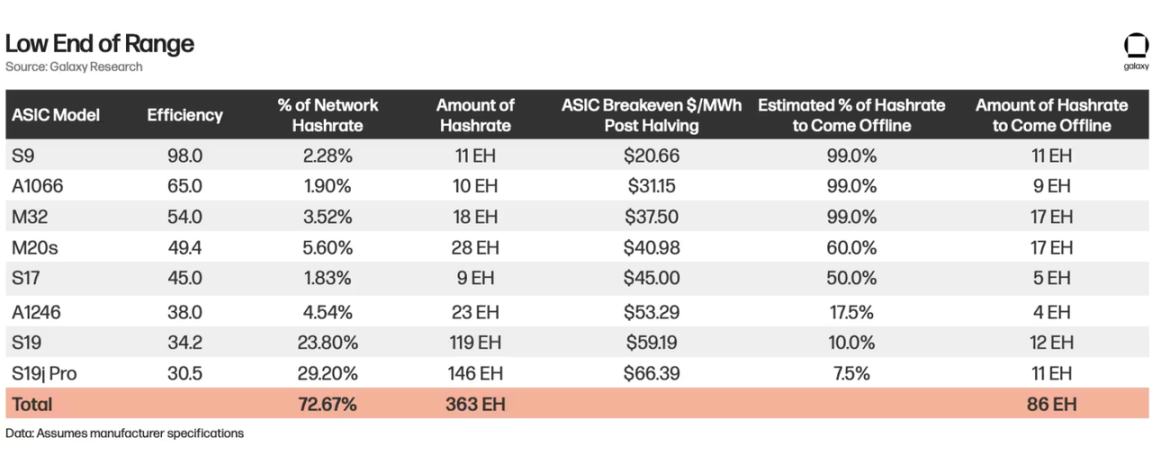
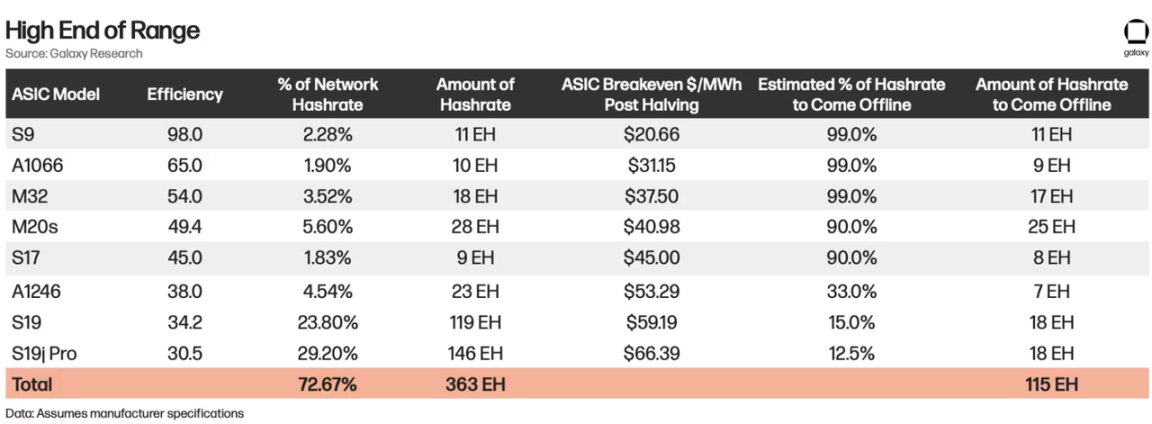
Conclusion
2023 was a year of growth and recovery for the mining industry, with miners benefiting from higher Bitcoin prices, increased transaction fees, and lower energy costs, resulting in significantly higher hash price and profits even as network hash rate doubled this year. Looking ahead to the halving, miners are leveraging improved liquidity in the equity capital markets and demand to fund new infrastructure expansion and ASIC purchases to increase efficiency.
As the halving approaches, we expect hash rate to continue rising, primarily driven by the installation of new generation machines such as the T21, S21, and M60 series. With the halving approaching and miners continuing to find their footing and adapt to the post-halving economic landscape, M&A activity in private mining and infrastructure may increase. Finally, we believe that transaction fee volatility is the biggest wildcard for the post-halving mining industry, as it will become a significant driver of hash price, difficulty, and block time differentials, with broader implications for pool payment schemes and miner signaling.
免责声明:本文章仅代表作者个人观点,不代表本平台的立场和观点。本文章仅供信息分享,不构成对任何人的任何投资建议。用户与作者之间的任何争议,与本平台无关。如网页中刊载的文章或图片涉及侵权,请提供相关的权利证明和身份证明发送邮件到support@aicoin.com,本平台相关工作人员将会进行核查。




